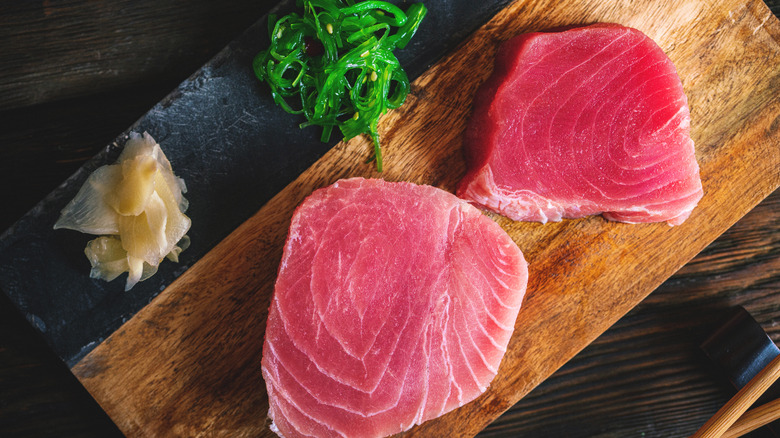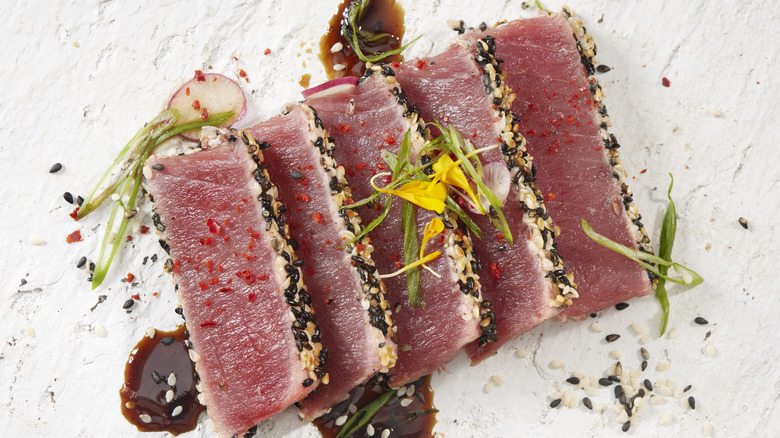Your Tuna Probably Gets Its Bright Red Hue From Carbon Monoxide
You know the saying "You can't read a book by its cover." Well, the same is true for tuna. Whether you eat it in a sandwich, in sushi, or as part of a poke bowl, it seems like the lean protein can be found almost anywhere. However, you might want to be careful when picking out a tuna steak because that beautiful ruby red color might not be what it seems.
That's because some tuna in the United States is infused with carbon monoxide gas, which amplifies this bright red color. A complex called carboxymyoglobin, which is created when the gas comes in contact with the fish's muscle pigments, is responsible for this shift. And though that fact might seem unsettling, it doesn't mean that the carbon monoxide in your tuna is dangerous. Carbon monoxide is not considered harmful if eaten, and the FDA does not prohibit the use of it in foods.
However, several other countries, such as China, Japan, and members of the European Union, have banned the process. Many in the United States have pushed for a similar ban. Why? Well, because that pump of carbon monoxide might be hiding something rotten in your tuna.
Taking off the rose-tinted glasses
Just because infusing carbon monoxide is safe for food consumption doesn't mean that the practice doesn't help to hide the rotten side of the tuna industry. After all, fresh tuna already has a pink or red hue to it, so why add carbon monoxide to enhance it? Certainly, this is sometimes done to make cuts of tuna look more appealing. However, carbon monoxide is often added to the large fish to mask or cover prior discoloration.
This is because when tuna is processed, frozen, or sits out for long periods, it begins to develop a brown color that can look unpleasant. This is sometimes called chocolate tuna by those in the fish processing industry, and though brown tuna is not always unsafe for consumption, it can look unappealing to customers who aren't used to seeing that hue, so the fish is infused with carbon monoxide to bring it back to that familiar red color.
Though discoloration isn't always a sign of spoilage, it can be. One concern among those advocating for a ban on carbon monoxide-infused tuna is that this practice actively covers signs of rot and spoilage in fish, potentially leading to food-borne illnesses. This is especially concerning when you consider the fact that tuna is often served raw in foods such as poke and sushi. Not being able to tell if a fish is good or bad can have severe consequences.
How to tell what's in your tuna
For starters, canned tuna is safe from this practice. Infusing carbon monoxide into tuna helps to retain the appearance of freshness, which is not necessary for pre-cooked tuna. However, when it comes to fresh and frozen tuna, it can be incredibly difficult to tell if carbon monoxide has been added to your fish. However, there are a few key signs that you should watch out for when trying to pick out the best cut of tuna. For one, an untreated piece of tuna will initially have red meat. But over a couple of days, its flesh will turn brown when it is exposed to air.
On the other hand, tuna that contains this gas will retain its red color even as the meat is actively deteriorating. So look out for cuts of tuna that are overly bright in color — this is a clear sign that the fish has been treated with carbon monoxide. Another indication is price. Higher-end cuts of tuna are less likely to be treated with the gas, but there is no clear labeling protocol for this practice, so it can be difficult to know for sure. However, many seafood companies opt not to sell fish infused with carbon monoxide, and indicate this practice on their website.


